Sai Kung District
| Sai Kung 西貢區 | ||
|---|---|---|
| District | ||
| Sai Kung District | ||
|
Day view of Tseung Kwan O in the Sai Kung District | ||
| ||
 Location of Sai Kung within Hong Kong | ||
| Coordinates: 22°22′53″N 114°16′14″E / 22.38143°N 114.27052°ECoordinates: 22°22′53″N 114°16′14″E / 22.38143°N 114.27052°E | ||
| Country | Hong Kong | |
| Region | New Territories | |
| Constituencies | 24 | |
| Government | ||
| • District Council Chairman | 吳仕福 Ng Sze-fuk, BBS, JP (DAB) | |
| Area | ||
| • Total | 136.39 km2 (52.66 sq mi) | |
| Population (2006) | ||
| • Total | 406,442 | |
| • Density | 3,000/km2 (7,700/sq mi) | |
| Time zone | Hong Kong Time (UTC+8) | |
| Website | Sai Kung District Council | |
| Sai Kung District | |||||||||||||
| Traditional Chinese | 西貢區 | ||||||||||||
|---|---|---|---|---|---|---|---|---|---|---|---|---|---|
| Simplified Chinese | 西贡区 | ||||||||||||
| |||||||||||||
Sai Kung District is the second largest district in Hong Kong in terms of area. It comprises the southern half of Sai Kung Peninsula and Clear Water Bay Peninsula in the New Territories plus a strip to the east of Kowloon. It is made up of the Sai Kung Town, Sai Kung rural areas, Tseung Kwan O New Town and over 70 islands of different sizes. The administrative centre is Sai Kung Town but the district's population is concentrated in Tseung Kwan O. The district has the second youngest residents. Known as the "back garden of Hong Kong", Sai Kung has been able to retain its natural scenery, and where the Hong Kong Global Geopark is located. Behind the modern buildings, a lot of traditional customs and cultures are still retained in the rural villages.[1]
Population and settlement
Sai Kung District covers approximately 136 square kilometres (53 sq mi) and as of 2006, it had a population of 406,442 in 2006, most of it in Tseung Kwan O.
Sai Kung Town
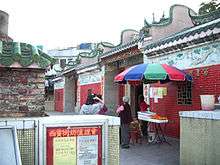
As a former fishing village, Sai Kung Town is a mecca for seafood lovers, locals and tourists alike. The designation of the country park areas during the 1970s was a huge boost to the local tourist industry. Sai Kung town underwent significant expansion during the 1970s when the High Island Reservoir and associated water scheme required some villagers and fishermen to be rehoused in Sai Kung. This provided a core of government-funded new development, both housing and commercial, in the town centre. This was followed by the Tui Min Hoi (literally 'over the harbour') development under the government's market town programme. Visitors can stroll around the regional market centre of Sai Kung Town or explore the back lanes, visit the Tin Hau Temple, feast on seafood or enjoy diverse delicacies at both Eastern and Western-style pubs and restaurants. There is also a famous dessert restaurant called Honeymoon Dessert that brings in many visitors from all over Hong Kong and even from abroad.
Tseung Kwan O

In addition to Sai Kung, Tseung Kwan O or Junk Bay, a booming new town, is also part of Sai Kung District. Tseung Kwan O connects Sai Kung Peninsula with the Kowloon urban area.
Junk Bay was once a natural bay area in Sai Kung, quite near the famous seafood village of Lei Yue Mun. There once was an iron and steel factory, and the area around Hang Hau Village was famous for the shipyards. In 1997, the Hong Kong Government started a major development project in this area, developing it into the seventh Hong Kong new town. Reclamation has since covered the whole bay area and it is now able to accommodate around 380,000 inhabitants, accounting for 95% of the district's total population. This new town was renamed Tseung Kwan O, its present name.
Tseung Kwan O now includes several high-rise residential estates and an industrial estate. The MTR metro system was extended to Tseung Kwan O, facilitating access to Sai Kung District.
Geography
In contrast to the densely populated areas of Hong Kong Island and Kowloon, Sai Kung District's heartland is a coastal area characterised by beautiful scenery, charming small villages and stunning seascapes. The area is known for its pristine beaches and quiet living. Inasmuch as it remains only partly urbanised, Sai Kung is known as the "last back garden" of Hong Kong.
UNESCO Global Geopark & Country Parks
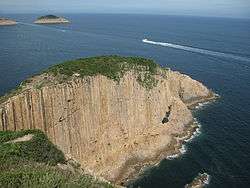
- Sai Kung Volcanic Rock Region, Hong Kong UNESCO Global Geopark
Sai Kung Volcanic Rock Region lie Sharp Island, High Island, the Ninepin Group and the Ung Kong Group (Wang Chau, Basalt Island and Bluff Island), where volcanic rocks, intrusive rocks and world-unique acidic hexagonal volcanic columnar rock joints created by Hong Kong's last large-scale volcanic activity some 16.5 million to 14 million years ago crop out. Together with a host of volcanic rock coastal landforms, form a comprehensive showcase of diverse and complex volcanic activities that explain Sai Kung's geological past.
- Sai Kung East Country Park
Sai Kung East Country Parkoccupies a vast area of east Sai Kung Peninsula. With the High Island Reservoir, High Island, Tai Long Wan, Pak Tam Au, Chek Keng, Sheung Yiu, Wong Shek Pier and the surrounding countryside, the 4,494 hectare protected area consists of the largest number of bays and coves among all country parks in Hong Kong. Part of the Geopark is also located there.
- Sai Kung West Country Park
Sai Kung East Country Park, including the Sai Kung West Country Park (Wan Tsai Extension), occupies a vast area of west Sai Kung Peninsula. Old preserved villages, such as Pak Sha O, Yung Shue O and Lai Chi Chong are the places of interest in this country park.
- Clearwater Bay Country Park
Clear water Bay Country Park occupies the rugged terrain around High Junk Peak, located in the eastern and the western part of the Clearwater Bay Peninsula. High Junk Peak, one of the four treacherous peaks in Hong Kong - is the no. 1 attraction of the Country Park.
Beaches
Sai Kung has some of the most beautiful and cleanest beaches in Hong Kong. Here is a list of the beaches in Sai Kung:
- Clear Water Bay 1st Beach
- Clear Water Bay 2nd Beach
- Silverstrand Beach
- Tai Long Wan (Big Wave Bay)
Tai Long Wan (Big Wave Bay), approximately 1.5 hours walk from the nearest road, is one of the few places in Hong Kong where surfing is possible, particularly in the winter months.
- Long Ke Wan
Islands
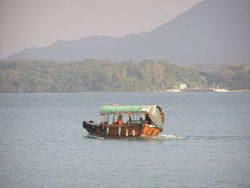
On summer nights, a lot of people hire small boats known as kaitos or sampan, some to catch cuttle-fish which is a popular pastime for local residents, others for leisurely trips through the island-dotted inland sea of Port Shelter. Popular islands to visit include:
- Kau Sai Chau
- Kiu Tsui Chau (Sharp Island)
- Leung Shuen Wan Chau (High Island)
- Pak Sha Chau (White Sand Island)
- Yeung Chau (Sheep Island)
- Yim Tin Tsai (Little Salt Field)
The large island of Kau Sai Chau is the location for a public golf course developed and run by the Hong Kong Jockey Club.
Local and tourist attractions
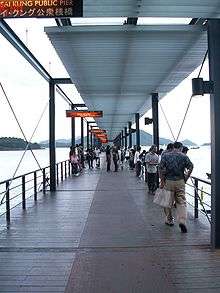
There are numerous cultural sites, heritage sites and country parks in the Sai Kung peninsula, such as:
- Hong Kong UNESCO Global Geopark
- Sheung Yiu Folk Museum (上窰民俗文物館), located in a former Hakka village
- Memorial Monuments for Sai Kung Martyrs During World War II (烈士墓園)
- Sai Kung Outdoor Recreation Centre (西貢戶外康樂中心)
- Lions Nature Education Centre (獅子會自然教育中心)
- Sai Kung East and West Country Parks (西貢郊野公園)
- Clear Water Bay Country Park (清水灣郊野公園)
- Che Kung Temple at Ho Chung (蠔涌車公廟)
- Tin Hau Temple at Fat Tong Mun (大廟, or 天后廟)
- Jin Island (or Tiu Chung Chau, 吊鐘洲)
- Leung Shuen Wan Tin Hau Temple (糧船灣天后廟)
- High Island Reservoir (萬宜水庫)
- Jockey Club Kau Sai Chau Public Golf Course (賽馬會滘西洲公眾高爾夫球場)
- Yim Tin Tsai Village and St. Joseph's Chapel (鹽田仔村及古老教堂)
The town centre of Sai Kung has a high concentration of seafood restaurants which attract a lot of tourists.
In addition there are golf courses and nature trails. The golf driving range center in Ho Chung is popular with local residents and tourists alike. Visitors can also enjoy barbecues at Ho Chung.
In recent years, the government has invested heavily in Sai Kung, with improvements being made to the town seafront, such as the Waterfront Park. An attractive mix of small boutique-style shops has sprung up as well, due to a sizeable expat population and increasing numbers of local visitors, selling everything from secondhand books to cat-themed accessories, and alternative lifestyle stores that offer items like surfboards, candles, incense, seashells, etc.
Transport
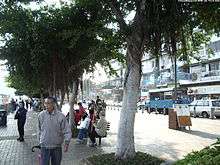
The MTR system's Tseung Kwan O Line currently has five stations in Tseung Kwan O New Town. The new town is also served by a comprehensive bus network that connects it to Kowloon via several main roads including Tseung Kwan O Tunnel and Po Lam Road.
Hang Hau Road and Ying Yip Road link Tseung Kwan O with Sai Kung Town and Clear Water Bay. The nearest MTR station to Sai Kung Town is Hang Hau.
Some of the most beautiful and thus isolated parts of Sai Kung Peninsula can only be reached on foot or by boat. Where a destination is accessible by public transport, it is usually served via a complicated network of bus routes. Information on certain bus routes may be found here.
The details of bus and minibus routes going to Sai Kung Town are as follows.
- Bus route 92 from Diamond Hill Station
- Bus route 99 from Heng On Estate (via Wu Kai Sha Station
- Bus route 299X from Sha Tin Town Centre (near Sha Tin Station)
- Bus route 792M from Tseung Kwan O Station (via Tiu Keng Leng Station
- Minibus route 1 from Telford Gardens (near Kowloon Bay Station)
- Minibus route 1A from Choi Hung Station (The most popular method)
- Minibus route 101M from Hang Hau Station (Quickest way from Hong Kong Island)
Scheduled ferry services also operate between coastal points on the peninsula and in and around the islands: .
Miscellaneous
The Hong Kong University of Science and Technology, one of the eight publicly funded tertiary institutions in Hong Kong, is located in Clear Water Bay, Sai Kung.
Coincidentally, the Chinese characters "西貢" for Sai Kung are also the Vietnamese chu nom characters for the name Saigon (now called Ho Chi Minh City), a major city in Vietnam.
Kitchee SC play in Tseung Kwan O Sports Ground.
Media
Sai Kung District is served by Sai Kung Magazine, a free-distribution English language monthly magazine and the community website Saikung.com. The magazine covers areas of Sai Kung Town, Clearwater bay, Pak Sha Wan, Ma On Shan and parts of Tseung Kwan O
See also
- Beaches of Hong Kong
- Hong Kong Country Parks & Special Areas
- List of buildings, sites and areas in Hong Kong
References
External links
| Wikimedia Commons has media related to Sai Kung District. |
- District Council website
- List and map of electoral constituencies 1 (large PDF file)
- List and map of electoral constituencies 2 (large PDF file)
- Tseung Kwan O New Town
- MacLehose Trail website
- Sai Kung Ho Chung Golf Driving Range Center
- Sai Kung country park website
- Explore Sai Kung – Portal about Sai Kung
- Sai Kung Magazine
- Sai Kung Forum
- Sai Kung House
- Sai Kung Map
- Sai Kung Home
 |
Tai Po District Sha Tin District |
|
 | |
| Wong Tai Sin District Kwun Tong District |
|
South China Sea | ||
| ||||
| | ||||
| Eastern District | South China Sea | South China Sea |

